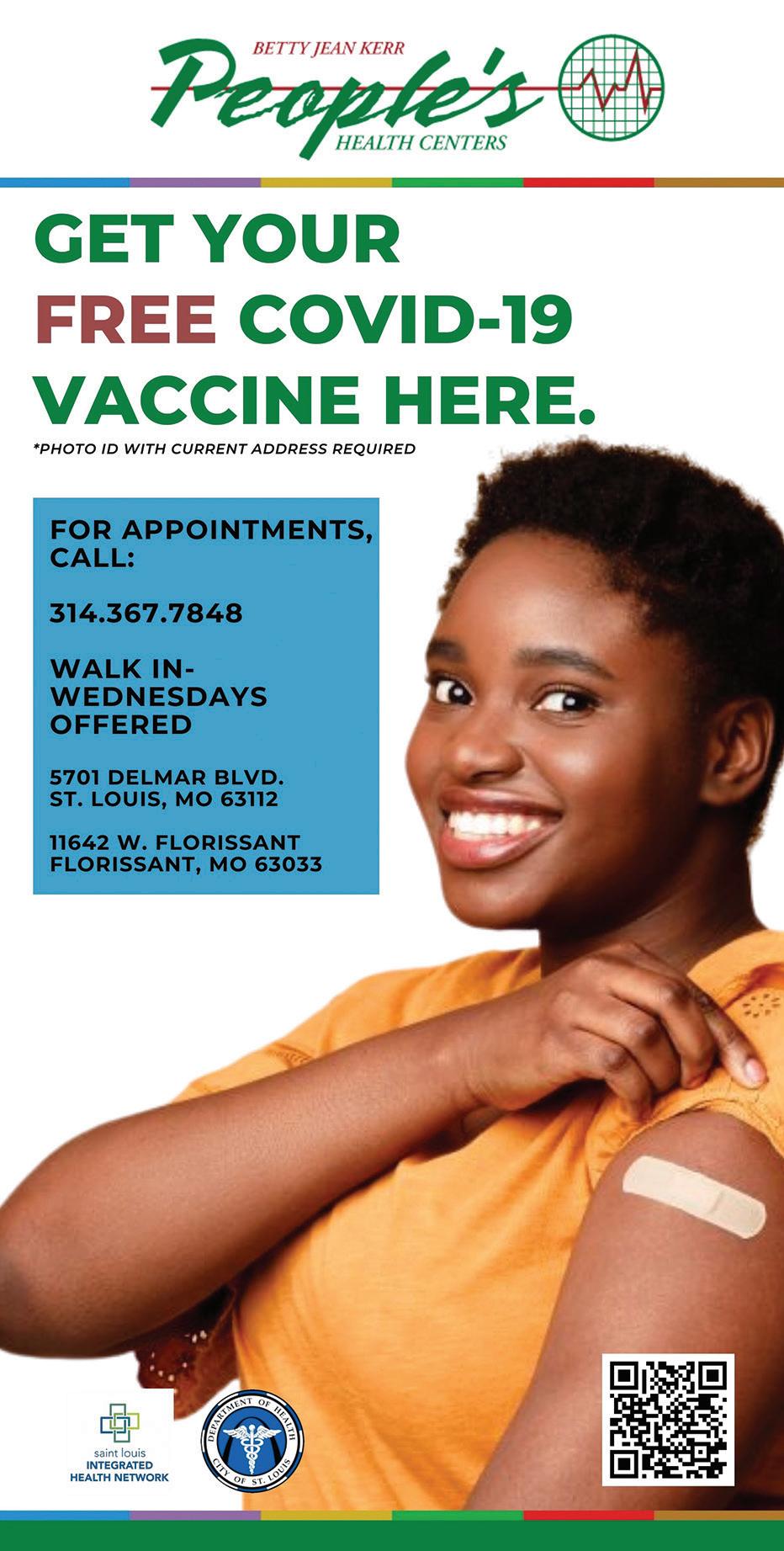& Wellness
HealtH & Wellness


Diabetes and your feet, what is essential to know
(StatePoint)
According to the American Diabetes Association (ADA), the prevalence of diabetes in non-Hispanic Blacks is 11.7%, versus only 7.5% in non-Hispanic whites.
Foot ulcers develop in about 15% of the 25 million Americans living with diabetes and are a top cause of hospitalization. These ulcers can lead to serious complications, such as infection and amputation.
According to foot and ankle surgeons, there are steps you can take to prevent complications and keep your feet healthy, as well as breakthrough treatments that are saving limbs, restoring mobility and improving lives.
“The majority of lower-extremity amputations are preceded by a reoccurring foot sore or an ulcer that won’t heal,” says John S. Steinberg, DPM, FACFAS, a board-certified foot and ankle surgeon and a fellow member and past president of the American College of Foot and Ankle Surgeons (ACFAS).
“Patients do best when they take charge of their foot health with the help of a foot and ankle surgeon.”
The surgeon members of ACFAS are sharing some important insights into preventing foot ulcers associated with diabetes and treating them if they do occur.
Make these precautions part of your foot care routine:
• Inspect feet daily using a flashlight and mirror to see the bottoms of your feet.
• Moisturize dry, cracking feet to prevent sores. Use powder to control moisture that can result in blisters.
• To prevent injury, wear protective, well-fitting shoes and socks at all times, even in the house. Change socks daily and more often if your feet get wet or sweaty. Avoid socks with holes or seams. Sometimes diabetic shoes are prescribed to avoid pressure and rubbing on the feet.
• Get regular foot exams from a foot and ankle surgeon, which can reduce

amputation risk by 45-85%. The surgeon can also screen feet for loss of protective sensation.
• Manage your diabetes. Out-of-control blood sugar levels can lead to nerve cell damage, making it harder to detect foot problems.
Look for telltale signs that an ulcer may be developing:
• Swelling. The foot or ankle may look puffy or engorged and larger than the other.
• Temperature. Cold feet might mean a circulatory issue, whereas hot feet might mean infection.
• Color changes. Redness and even other colors might appear before an ulcer
forms.
• Calluses. If a callus changes colors or develops dark, “dried blood” colored spots, it may be time to have a foot and ankle surgeon offer a proper diagnosis.
If you do experience a non-healing ulcer, talk to your foot and ankle surgeon right away about innovative technologies that stimulate healing.
Groundbreaking approaches include stem cell therapy, the use of bioengineered skin substitutes to accelerate growth of healthy skin, and negative pressure wound therapy (NPWT) to promote healing and enable healthy, new tissue to grow.
Today, foot and ankle surgeons rarely do a skin graft without NPWT. Skin grafting for foot ulcers has also advanced.
African Americans are almost twice as likely to have diabetes than white Americans. An important part of diabetes management is foot care. Black patients also have a higher rate of amputation because they are diabetic.
Surgeons now use advanced reconstructive surgery and grafting techniques to promote wound healing and decrease wound recurrence.
The success rate of these advanced therapies is high, providing substantial improvement over treatments of the nottoo-distant past, when doctors would clean and bandage the wound and hope for the best.
“Thanks to the many advances in diabetic foot care, patients today are having simpler surgeries, avoiding amputations, and getting back to everyday life sooner than ever before,” says Dr. Steinberg. For more information or to find a foot and ankle surgeon near you, visit FootHealthFacts.org, the patient education website of the American College of Foot and Ankle Surgeons.
Falling back into healthy habits
Walk, watch your diet
(StatePoint)
The fall season is upon us and it’s the perfect time to reset and renew. Simple and small modifications to your daily exercise and nutrition routines can make a huge difference—and these three easy tips will help you “fall” back into a good routine.
Sneak in extra steps
Fall is a refreshing time of year to get moving, especially as we welcome a break from the summer heat. Engaging in simple cardiovascular exercise weekly is key. It can help maintain healthy cholesterol and blood pressure levels. If working out regularly is daunting, instead, find simple ways to be active in your daily life. Use a smaller cup for your water, allowing you to get up more often to refill it, take the stairs instead of the elevator or park a bit farther from your destination—all these habits will encourage you to take more steps per day.
Make healthy swaps
Looking to eat healthier? The fall season offers an abundance of delicious vegetables and fruits for an easy swap out. Start small by trading out a bag of chips for an apple or fries for sweet potatoes. You are what you eat, and your gut microbiome plays a major role in your health.
Ultra-processed diets negatively impact gut health and throw off the omega-6 to omega-3 ratio, which can lead to chronic inflammation. Inflammation lessens your ability to function properly at the cellular level and increases your vulnerability to lifestyle diseases.
Focus on whole body health
A fall reset should focus on whole body health and that starts with your cells. Your body is made up of trillions of cells that help keep you functioning and thriving and supporting them is crucial.

Finding ways to take more steps each day, including walking in the fall air, can help maintain healthy cholesterol and blood pressure levels.
Krill oil is an effective supplement for keeping your cells and whole body healthy. What distinguishes krill oil from other marine oils, is that it is a natural multi nutrient. Meaning, that from the source, krill oil already contains several essential and cellular nutrients all in one, including omega-3s, phospholipids, choline and astaxanthin. The body’s cells need to get these nutrients from the diet on a consistent basis.
In krill oil, the omega-3s are bound to phospholipids, making them more easily absorbed by the body. This means you get more of the beneficial omega-3s in a form that your body can use efficiently.
“By adding a supplement like krill oil to our lives, we are helping ourselves in a big way,” says Thomas Repstad, nutritionist and global technical marketing manager at Aker BioMarine, a biotech innovator and supplier of Superba Krill.
“The real X factor in krill oil is its phospholipid advantage. Around each cell and membrane, we have phospholipids that help maintain the cell’s strength, flexibility, and integrity. Phospholipids are also naturally found in krill oil, delivering total body benefits at a cellular level.”
Let these three tips be an easy and effective way for falling back into a healthy routine this season and beyond.
Learn more at www.krilloil.com.
Keeping your brain healthy means keeping it active
By Reginald Williams The AFRO
For many aging adults, cognitive decline can create a good bit of anxiety.
According to the Alzheimer’s Association, “while older Black Americans are twice as likely as older Whites to have Alzheimer’s or another dementia, research hasn’t yet identified the cause.”
The organization also reports that “among Black Americans ages 70 and older, 21.3% are living with Alzheimer’s, a type of dementia that affects memory,
thinking and behavior.”
Experts say lifestyle and social indoctrination are the primary culprits driving neurodegenerative disease– not aging.
“Aging is not a disease,” said Dr. Sharon Brangman, chair of the Department of Geriatrics at Upstate Medical University in Syracuse, New York.
“It’s a part of the natural process,”
Multitasking, often celebrated and exalted in the workplace, is a primary felon of brain decline.
Socially, multitasking is believed to be an aptitude that yields numerous ben-
efits. Research suggests that it reduces procrastination while increasing engagement and productivity. Business experts favor multitasking because they think it saves time and reduces costs.
One employee’s assumed multitasking flexibility often eliminates the need to hire additional employees. Experts believe multitasking improves mental agility. Medical research, however, counters the business perspective on multitasking.
According to Brangman, mind juggling poses one of the greatest threats to cognitive brain health.
“There’s a saying that multitasking makes you stupid. Your brain just can’t do multiple things at the same time, and it becomes even more difficult as we get older,” said Brangman, who also serves as the director of the Center of Excellence in Alzheimer’s Disease.
“Your boss or someone you work or interact with thinks it’s great if you can try to do multiple things at the same time. But our brains were made to do just one thing at a time. Actually, if you try to multitask, you can slow down



Banker pettigrewt@stifelbank.com | (314) 317-6902 (314) 550-2574 cell | NMLS# 398804

Fruits and vegetables, whole grains, low-fat dairy and lean protein should be on the menu for all seniors, especially African Americans because of higher rates of diabetes, hypertension and health ailments that can increase with age.
Avoid common obstacles to good nutrition
A key to healthy aging
(StatePoint)
Nutrition is critical to older adults’ overall vitality, providing energy, helping to control weight, and even preventing
and managing some diseases.
Unfortunately, 10% of older people don’t eat enough, while one-third eat too much, according to HealthinAging. org, which is the Health in Aging Foundation’s online public education resource. Such nutritional imbalances may be due to the range of common obstacles some people face as they age, including changing tastes, dental problems and difficulty accessing healthy
foods.
“Charles,” a Cigna Healthcare Medicare Advantage (MA) customer, had several health issues when he was introduced to a nutrition program available through his MA plan. Through the program, he worked with a registered dietitian, started working out, and lost nearly 50 pounds. These changes fueled him to tackle additional health goals, including getting mental health support and assis-
tance improving his sleep. MA plans, like those offered by Cigna Healthcare, include “extra benefits” not available through Original Medicare. The Cigna Healthcare MA nutrition program is one of those extras, and it primarily supports older adults with a body mass index below 22 or above 40, those with chronic diseases

Nutrition
Continued from D5
like diabetes and kidney disease, and those with low fruit and vegetable intake. Through the program, registered dietitians provide customers with dietary advice that can help them improve their health.
“We offer information, education and resources that are different for everybody and not restrictive,” explained Robin Neal, RD, one of the program’s dietitians. “The goal is to provide skills and tools so individuals can self-manage their diet after the program ends.”
Neal said results often include weight loss and improved blood sugar readings, such as those Charles experienced.
Of course, program advice varies by individual and their unique nutritional needs, but some tips everyone can benefit from include the following:
Get your nutrients. According to the National Council on Aging, older adults should eat a variety of foods to get all the nutrients they need, including lean protein for muscle mass, as well as fruits and vegetables, whole grains and lowfat dairy. Choose foods with little to no added sugar, saturated fats and sodium. For an example of what a healthy plate looks like, visit myplate.gov.
Stay hydrated. Drink water often to aid digestion. Limit beverages with lots of added sugars or salt.
Visit the dentist. If you’re having trouble chewing, visit your dentist. They may be able to help. For instance, if you have ill-fitting dentures, chewing can be improved and more comfortable with a better fit. Additionally, choosing softer foods, such as canned fruit, soups or tuna, may help. Dental visits are a covered benefit in many Medicare Advantage plans.
Follow food safety guidelines. Food not prepared properly can make you sick. Because those with weakened immune systems are vulnerable to foodborne illnesses, it’s especially important for older adults to follow food safety guidelines. If you have any doubt about a food’s safety, throw it out.
Limit salt. Too much sodium can increase the risk of high blood pressure, heart attack and stroke. To stay heart healthy, ask your doctor for guidance on recommended daily sodium limits based

Drink water often to aid digestion. Limit beverages with lots of added sugars or salt.
on your health status and check food labels for sodium content. Cook more meals at home using lower sodium ingredients and avoid processed foods. Flavor dishes with herbs and spices.
Seek assistance if needed. Take advantage of MA plan benefits that can help you secure healthy foods, like transportation or grocery cards. Additionally, there are local and national programs to help those on limited incomes with nutritious food costs, including the Supplemental Nutrition Assistance Program (SNAP). To learn about assistance available in your area, visit cignacommunity.findhelp.com.
To find MA plans offered in your area, visit Medicare.gov. For information on Cigna Healthcare plans, visit CignaMedicareInformation.com.
“By devoting your time and attention to eating well, you’ll not only be able to maintain a healthy body weight, but you can also reduce your risk of chronic disease and maintain your overall vitality as you age,” said Neal.
“And, of course, if you have any questions about your health, you should always talk to your doctor.

Brain
Continued from D4
brain functions.”
Additionally, Black people are at higher risk of suffering from other health issues.
African Americans are disproportionately affected by high blood pressure, stroke, diabetes and heart disease. Lack of sleep and stress also exacerbate a disease cycle, too often caused by life choices and a lack of options tied to better health outcomes. This curates the perfect environment for chronic illnesses and diseases including dementia and Alzheimer’s Disease.
As a person ages, their brain will change in how it functions. However, forgetting things like why you entered a room or not being able to remember someone’s name is a natural, normal process of aging. Brangman maintains that the brain holds thoughts—storing lots of information. It behaves like a computer’s hard drive filled with data.
“It might take a little longer to get through all those files to get the right word out,” said Brangman. However, when forgetting information impacts the ability to get through the day, like what the Preyars experienced, it is the time to see a medical professional about overall
Walking is great for your health, and walking with partners does wonders for your brain, as well. Brain activity can help people avoid the Alzheimer’s.

Do you worry about running out of money during your retirement years? If so, how can you help prevent this from happening?
brain health.
Despite the prevalence of brain decline in African Americans, intentionally making good health choices reduces the risk of brain decay. Brangman says it’s essential that we know what to do to maintain brain health.
The Global Council on Brain Health (GCBH), in an article published by AARP on brain health, identified the following six pillars of brain health:
1. Be social
2. Enjoy your brain
3. Manage stress
4. Engage in exercise
5. Make sure to experience restorative sleep – no less than eight hours
6. Eat nutritionally dense meals
Forgetting things doesn’t mean you are in an Alzheimer’s or dementia episode; it’s a typical path of cognitive aging. Be cognizant of potential brain deterioration, but know you can proactively help reduce brain dysfunction.
Additional resources for cognitive health are located at https://mcknightbrain.org/brainworks/
In the first place, if you have this type of fear, you’re far from alone. Consider this: 58% of retirement savers from all age groups, including current retirees, say that outliving their assets is their greatest retirement fear, according to a study by Cerulli Associates, a financial services research organization. This type of fear can certainly affect your quality of life when you retire. Still, there’s no need to panic — because you can take steps to help prevent the running-out-ofmoney scenario.
Here are a few to consider:
Know how much you’ll need during retirement. You need to get a clear picture, or at least as good an estimate as possible, of how much money you’ll need to support your retirement lifestyle. Once you do retire, some costs, such as transportation or other work-related expenses, might go down, while others — medical expenses, in particular — will likely go up. The fear of running out of money, like many fears, is caused largely by what you don’t know, so having a good sense of how much you’ll need in retirement can help reduce your anxieties.
Build financial resources before retirement. You’re probably at your peak earning capacity in the years close to your retirement, so consider contributing as much as you can afford to your IRA and 401(k) or other employer-sponsored retirement plan.
Maximize your Social Security payments. You can start collecting Social Security as early as 62, but your monthly benefits will be larger if you can afford to wait until your full retirement age, between 66 and 67. (Payments will “max out” at age 70.)
Re-enter the workforce. Going back to work in some capacity is one way to possibly help build retirement resources and delay taking Social Security. If you have a particular area
of expertise, and you enjoyed the work you did, you might be able to go back to it on a part-time basis or do some consulting. You could boost your cash flow, and potentially extend your contributions to an IRA and to an employer’s retirement plan.
Cut costs during retirement. Possibly the biggest cost-cutting measure is downsizing — are you willing and able to move to a less expensive area or scale down your current living space? Of course, this is an emotional decision, as well as a financial one, and downsizing isn’t for everyone, but it might be something to at least consider. As for the lesser ways of reducing expenses, take advantage of senior discounts, which are offered in many areas, including entertainment, public transportation, restaurants and retail establishments. And look for other opportunities, such as cutting out streaming services you don’t use.
Look for more income from your investments. As you get closer to retirement, and even when you do retire, you might want to adjust your investment portfolio to provide you with more income-producing opportunities. However, even as a retiree, you’ll want some growth potential in your investments to help keep you ahead of inflation.
Ultimately, the more you can bolster your financial security before and during retirement, the less fear you may have of outliving your money.
Aaron Ezell, CRPC®
9666 Olive Blvd Suite 180
Olivette, MO 63132
314-997-4905

aaron.ezell@edwardjones.com
Four tips for choosing the right Medicare plan
(StatePoint)
With so many Medicare options available, selecting a plan can seem daunting. This year you may be wondering how news of Medicare drug price negotiations, economic uncertainties and other factors may impact your coverage in 2025.
Medicare is the government health insurance program for Americans 65 and older and others who qualify, providing hospital coverage (Part A) and physician visits (Part B) to beneficiaries. Additionally, there are a variety of options that coordinate with original Medicare, such as Medicare Supplement plans and Prescription Drug Plans, or replace original Medicare with Medicare Advantage (MA) plans combined with Prescription Drug Plans.
During this year’s Medicare Annual Enrollment Period (AEP), which takes place between Oct. 15-Dec. 7, 2024, here’s what Cigna Healthcare, which serves millions of Medicare customers nationwide, wants you to know:
1. Check for plan changes: If your current plan is working for you, you can likely keep it. However, it’s a good idea to review your plan every AEP, especially if you’ve experienced major life, health or financial changes. Any changes to your current plan will be outlined in your Medicare plan’s Annual Notice of Change (ANOC) letter, which you can expect to receive in September.
2. Research your coverage: There are a few key things to watch for when shopping for a plan. One of them is whether your favorite providers and specialists will be in-network. You should also review each plan’s formulary – that is, the list of drugs covered under the plan. You’ll want to find a plan that

Medicare Annual Enrollment Period (AEP) runs through Dec. 7. Current recipients should check their respective plans for changes. If satisfied with the plan, you likely can keep it.
will cover your current medications and any you anticipate your doctor prescribing over the course of the year ahead. Finally, carefully consider your total spend for your prescription drug plan coverage (i.e., premiums plus pharmacy costs) since the maximum out-of-pocket costs for drugs you utilize will be capped at $2,000 in 2025.
3. Look for value: No matter what the economic outlook is, it’s wise to select a plan that provides great value. To that end, you may want to consider an MA plan, which offers quality and affordability. MA plans cover everything
original Medicare does, plus more; most also include dental, vision and hearing benefits, prescription drug coverage, and other extras like over-the-counter drugs, transportation to doctor’s visits and pharmacies, healthy grocery purchases, and fitness services. MA plans are often available with $0 premiums, but you’ll also want to check on what your annual out-of-pocket costs could be based on your health status.
4. Understand your plan: Before enrolling in a particular plan, make sure you understand its ins and outs. Call Medicare at 1-800-MEDICARE (1-800-
633-4227) 24/7; TTY users can call 1-877-486-2048. Or, visit the Medicare Plan Finder website at Medicare.gov/ plan-compare. For local assistance, refer to the State Health Insurance Assistance Program at www.shiptacenter.org. You can also contact individual Medicare plans, including Cigna Healthcare at CignaMedicareInformation.com.
“AEP is your opportunity to assess your budget and your health needs and find an option that will work for you and your lifestyle in 2025,” says Ryan Kocher, chief growth officer for Cigna Healthcare Medicare.
